by Damir Šegon, Denis Vida and Paul Roggemans
Abstract: A new meteor shower on a Jupiter-family comet orbit (TJ = 2.34 ± 0.16) orbit has been detected during September 23–24 by the Global Meteor Network. Meteors belonging to the new shower were observed between 176° < λʘ < 187° (2024, September 19–29) from a radiant at R.A. = 240° and Decl.= +77° in the constellation of Ursa Minor, with a geocentric velocity of 32 km/s. The new meteor shower has been listed in the Working List of Meteor Showers under the temporary name-designation: M2024-S1.
Introduction
On 26 September 2024, Yury Harachka from Belarus reported that the Belarusian meteor network registered a distinct group of three radiants in the constellation of Ursa Minor during the night of 24-25 September. No corresponding known meteor shower could be found. A fourth registration came from Odessa, Ukraine (Harachka et al., 2024).
At the same time the Global Meteor Network radiant plot for 23-24 September displayed a radiant hot spot not related to any other meteor shower (Figure 1). A quick analysis of the available orbit revealed a concentration of 31 orbits recorded during the nights of 2024 September 23–25 (GMN website). All meteors appeared during the solar-longitude interval 181.0° – 183.0°, with a peak at 181.9°. The shower is similar to but distinct from epsilon-Ursae Minorids (EPU#1044) which have been observed 5 degrees away in 2020 and 2022. A CBET announcement was prepared and published (Vida and Šegon, 2024) and the new meteor shower was registered by the the IAU Meteor Data Center and got the temporary identification M2024-S1.
The shower was independently observed by cameras in 18 countries worldwide (Belgium, Bulgaria, Canada, Croatia, Czech Republic, Denmark, France, Germany, Greece, Hungary, Luxembourg, Mexico, Slovakia, Slovenia, South Korea, the Netherlands, United Kingdom and the USA). The meteors were bright, most having peak magnitudes brighter than +0.0.
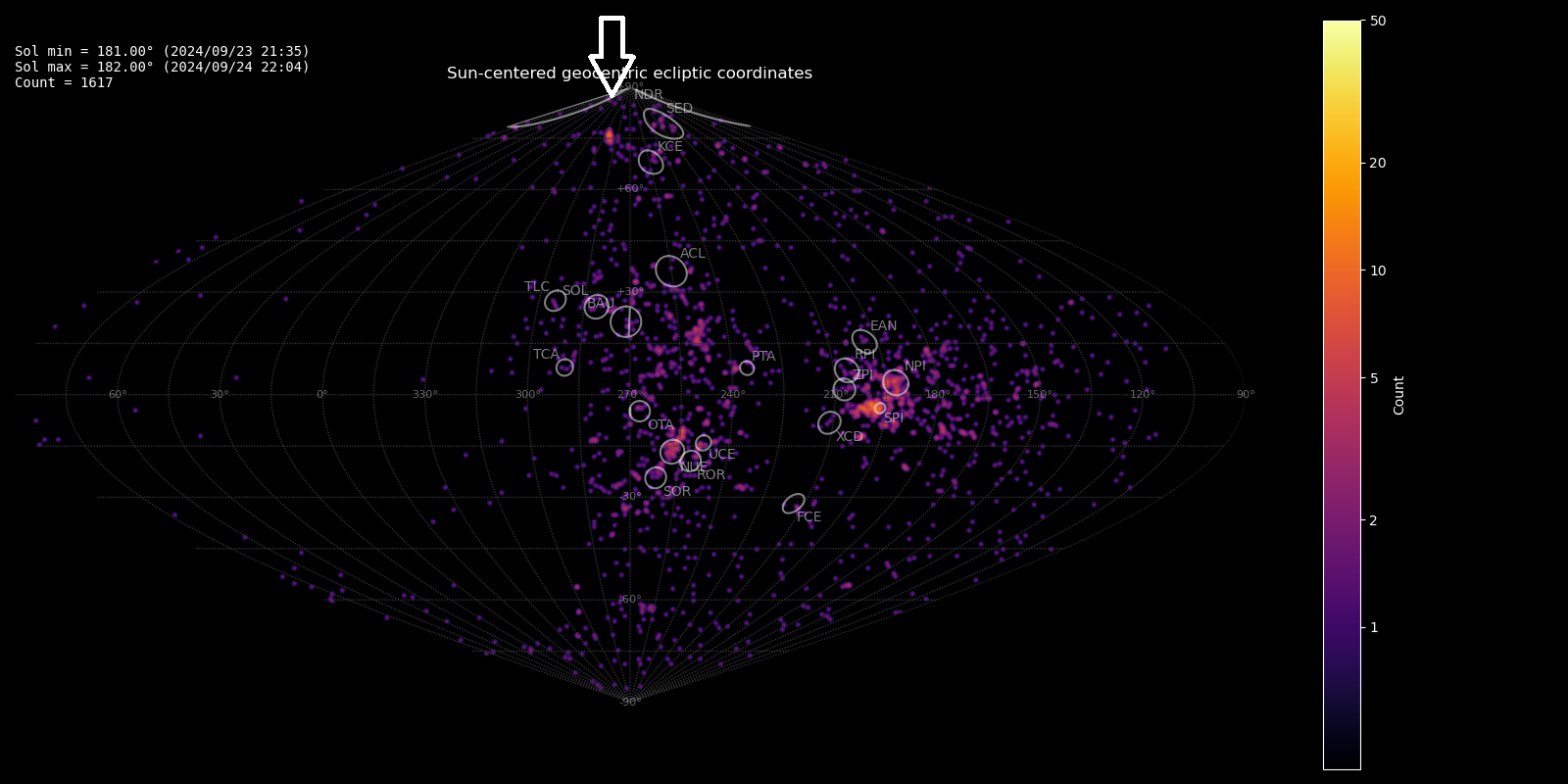
Figure 1 – Radiant plot of the Global Meteor Network data for 2024 September 23–24 in Sun-centered geocentric ecliptic coordinates. The new radiant is visible at high ecliptic altitude and marked by a red arrow.
Discovery and first analysis
We used the procedure as described for some recent cases of possibly new showers in Bootes and Draco (Šegon et al., 2023). The Drummond dissimilarity criteria DD has been chosen for the analysis of the new radiant concentration. A first iteration revealed a clear concentration of orbits, as it can be seen on Figure 2. The Railey distribution fit pointed at a DD value of 0.05 as the orbital similarity cutoff (Figure 3), which resulted in 31 orbits representing the possibly new meteor shower.

Figure 2 – Histogram of the distribution of the Drummond DD criterion values valid for the final mean orbit.

Figure 3 – Rayleigh distribution fit and Drummond DD criterion cutoff.
The presence of non-shower radiants in the area around the possibly new shower (Figure 4) shows the cutoff to be reliable since the density of meteor radiants does not look affected after removing shower members (plotted as pale diamonds). The plot of the shower meteor radiants in equatorial coordinates shows a very compact group, with a standard deviation of the distances from the average radiant position of about a single degree (see Figure 5). The Π–i diagram shows a compact group of radiants too (Figure 6), without any other groups of radiants to be seen.

Figure 4 – All non shower meteor radiants in geocentric equatorial coordinates during the shower activity. The pale diamonds represent the new shower radiants plots, error bars represent two sigma values in both coordinates.

Figure 5 – The reverse of Figure 4, now the shower meteors are shown as circles and the non shower meteors as grayed out diamonds. Note that there are no other groups of meteor radiants to be seen in the vicinity of the possibly new meteor shower.

Figure 6 – The diagram of the inclination i against longitude of perihelion Π shows a distinct group of radiants without any other groups to be seen.
The activity period (Figure 7) considered in the first analysis on the first available orbit data was limited to the interval 181° < λʘ < 183° (2024, September 23–24) but it was noticed that more related events could have been detected outside this observing window. A second more in depth analysis was postponed until all orbit data for this period had been processed. The first analysis provided solid proof that a thus far unknown shower had been detected.

Figure 7 – The activity period with the number of orbits identified as new shower members.
The only nearby meteor shower, epsilon-Ursae Minorids (EPU#1044), observed 5 degrees away in 2020 and 2022. The new shower is similar to but distinct from these epsilon-Ursae Minorids, with orbital elements outside of the measurement errors of our new shower (Table 1), although we do not exclude the possibility of the showers being dynamically related.
Table 1 – Known neighboring shower, epsilon-Ursae Minorids (EPU#1044), (Shiba, 2022), compared to the new meteor shower, derived by two different methods.
| EPU | New (Šegon) | New (Roggemans) | |
| λʘ (°) | 181.9 | 181.9 | 181.4 |
| λʘb (°) | 181.02 | 181.0 | 176.2 |
| λʘe (°) | 182.99 | 182.6 | 186.8 |
| αg (°) | 255.0 | 238.3 | 240.3 |
| δg (°) | +82.6 | +77.3 | +77.3 |
| Δαg (°) | –3.35 | – | |
| Δδg (°) | –0.41 | – | |
| vg (km/s) | 33.6 | 32.0 | 31.7 |
| λ (°) | 96.8 | 118.5 | 117.1 |
| λg – λʘ (°) | 274.9 | 296.6 | 295.5 |
| βg (°) | 73.6 | 75.7 | 76.1 |
| a (A.U.) | 2.756 | 3.11 | 3.01 |
| q (A.U.) | 1.003 | 0.994 | 0.995 |
| e | 0.636 | 0.680 | 0.669 |
| i (°) | 57.8 | 53.9 | 53.4 |
| ω (°) | 178.7 | 169.2 | 169.7 |
| Ω (°) | 181.9 | 181.8 | 181.0 |
| Π (°) | 0.6 | 351.0 | 350.8 |
| Tj | 2.49 | 2.34 | 2.40 |
| N | 10 | 31 | 55 |
Another search method
Another method has been applied to check this new meteor shower discovery. The starting point here can be any visually spotted concentration of radiant points or any other indication for the occurrence of similar orbits. The method has been described before (Roggemans et al., 2019). The main difference with the method applied in Section 2 is that three different discrimination criteria are combined in order to have only those orbits which fit different criteria. The D-criteria that we use are these of Southworth and Hawkins (1963), Drummond (1981) and Jopek (1993) combined. Instead of using a cutoff value for the D-criteria these values are considered in different classes with different thresholds of similarity. Depending on the dispersion and the type of orbits, the most appropriate threshold of similarity is selected to locate the best fitting mean orbit as the result of an iterative procedure.
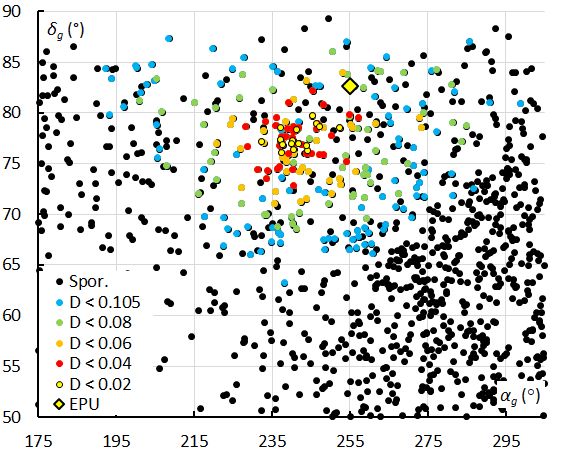
Figure 8 – Radiant plot in geocentric equatorial coordinates for different similarity thresholds, the radiant of the epsilon-Ursae Minorids (EPU#1044) is marked as a yellow diamond.
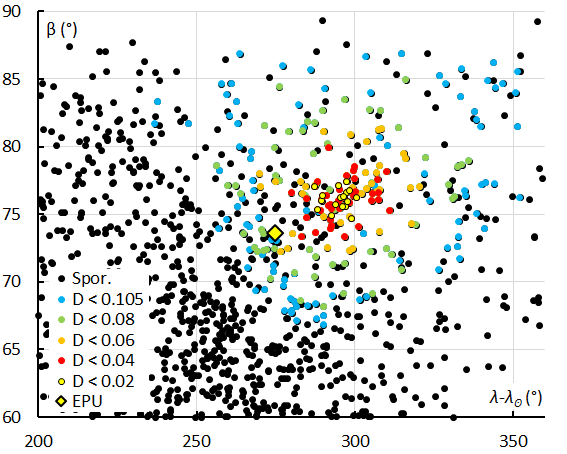
Figure 9 – Radiant plot in geocentric Sun-centered ecliptic coordinates for different similarity thresholds, the radiant of the epsilon-Ursae Minorids (EPU#1044) is marked as a yellow diamond.
This method detects 55 candidate orbits with similarity criteria better than DD < 0.04, DSH < 0.1 and DJ < 0.1. The concentration of these radiants (red and yellow dots) is obvious in Figures 8 and 9, away from the radiant of the epsilon-Ursae Minorids (marked as a yellow diamond). The mean orbit computed according to Jopek et al. (2006) for the orbits selected using the method of Šegon et al. (2023) is listed as New (Šegon) in Table 1, the mean orbit for the selection using the method of Roggemans et al. (2019) is listed under New (Roggemans). The dispersion of radiants with less good similarity are also shown in Figures 8 and 9, but these orbits were not used to compute the mean orbit to avoid contamination with sporadics. As expected, similar orbits were detected over a longer time span, 176.2° < λʘ < 186.8° (2024, September 19–29).
The concentration of the orbits of the newly discovered meteor shower appears very distinctly in the diagrams of the inclination i against the longitude of perihelion Π (Figure 10). The position of the epsilon-Ursae Minorids is marked as a yellow diamond and appears clearly offset from the new meteor shower orbits. Looking at the velocity distribution for the 55 orbits (Figure 11), the higher the inclination, the higher the velocity, the EPU is outside this diagram.
Looking at a couple less common diagrams like eccentricity e against the longitude of perihelion Π (Figure 12) and inclination i against the perihelion distance q (Figure 13), clearly shows the distance between the concentration of the new meteor shower orbits and the epsilon-Ursae Minorid position.
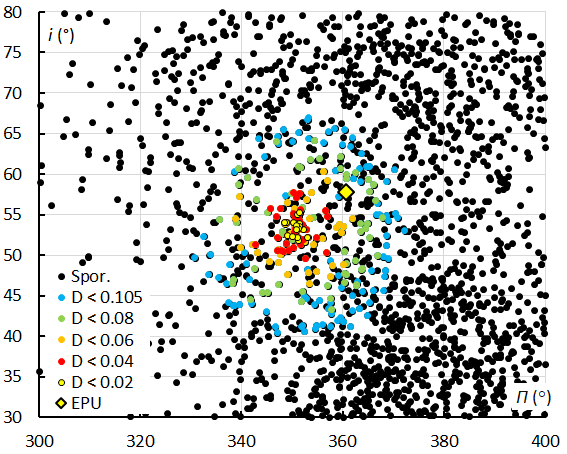
Figure 10 – Diagram of the inclination i against the longitude of perihelion Π, the radiant of the epsilon-Ursae Minorids (EPU#1044) is marked as a yellow diamond.
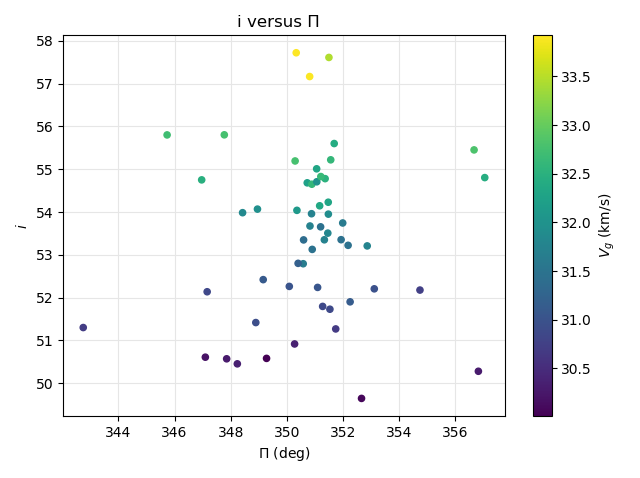
Figure 11 – Diagram of the inclination i against the longitude of perihelion Π, colorcoded for the geocentric velocity vg.
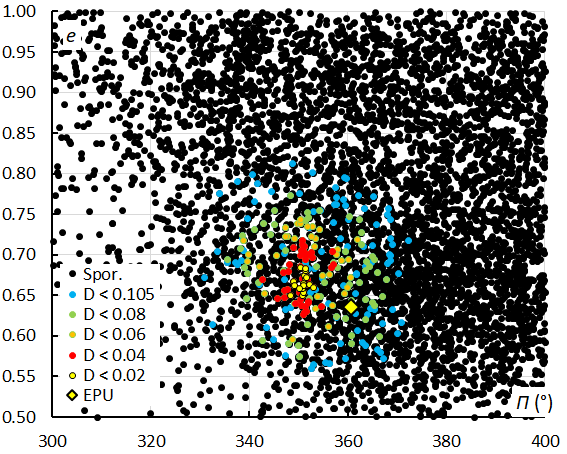
Figure 12 – Diagram of the eccentricity e against the longitude of perihelion Π, the radiant of the epsilon-Ursae Minorids (EPU#1044) is marked as a yellow diamond.
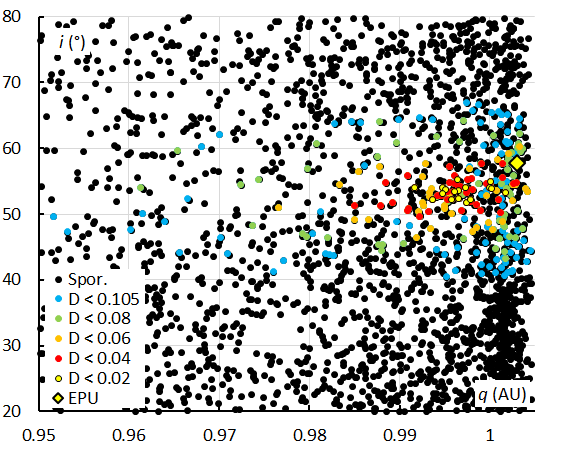
Figure 13 – Diagram of the inclination i against the perihelion distance q, the radiant of the epsilon-Ursae Minorids (EPU#1044) is marked as a yellow diamond.
Comparing older data and other datasets
Looking up past years orbit data for Global Meteor Network (2018–2023, 1174206 orbits), we find 68 orbits with DD < 0.04. Two in 2019, 1 in 2020, 9 in 2021, 25 in 2022 and 31 in 2023, spread over different nights. This increase from year to year reflects the expansion of the GMN network. With 8 or 9 orbits in single nights in 2022 and 2023, this shower remained just under the detectability threshold. The SonotaCo net orbit data (2007–2022, 443197 orbits) has only 6 orbits with DD < 0.04, recorded in different years. EDMOND (2001–2023, 508266 orbits), has 15 orbits with DD < 0.04 in different years. The CAMS orbit data (2010–2016, 471582 orbits), has 12 orbits with DD < 0.04, recorded in different years between 2011 and 2016.
The shower has been active in past years but the level of activity was too low for the major video camera networks. The large number of cameras of GMN in 2024 made it possible to detect this weak activity.
Parent body
The parent body search suggests a possible parent body to be 2021 HK12. This object matches the new meteor shower orbit with a similarity criterion DSH = 0.15 (Southworth and Hawkins, 1963) and has orbital parameters:
- q = 1.036 AU,
- e = 0.685,
- i = 47°,
- ω = 168.8°,
- Ω = 187.1°.
Discussion
The nearby epsilon-Ursae Minorids (EPU#1044) with its Jupiter-family comet orbit, and the new meteor shower M2024-S1 maybe dynamically related, but there is a clear offset between both orbits. When we use the orbit given by Shiba (2022) as feed to locate similar orbits we find 11 orbits applying the same similarity criteria as for the new meteor shower. This dataset of 11 orbits has no orbits in common with the dataset with 55 orbits that define the new meteor shower.
The original detection of the epsilon-Ursae Minorids (EPU#1044) by Sato in 2019 (Sato, 2020) was based on 12 orbits recorded by SonotaCo and 7 orbits by CAMS. Shiba (2022) used 10 orbits from 2019 to compute the orbit for EPU#1044. These numbers are very small and at the very limit to estimate a mean orbit for such meteor shower. The number of orbits used to define this new meteor shower is larger and therefore statistically more significant. A too small sample of orbits could imply a selection effect resulting in a slightly different orbit.
Jenniskens (2025) compared the observed variation in ecliptic longitude of the shower radiants in the past and suggests that the 2024 outburst can be a return of the epsilon-Ursae-Minorids, rather than a new meteor shower. The number of detected orbits of this shower can be partly explained as due to the expansion of the GMN camera network but the activity level of this shower in 2024 between solar longitude 181° and 183° was definitely higher than in previous years. In past years meteor orbits were recorded from this new shower but the activity level was too low to catch anyone’s attention.
Conclusion
A possibly new meteor shower in the constellation of Ursa Minor active during 10 days, has been detected in the Global Meteor Network orbit data for September 19–29, 2024. The resulting orbit is a Jupiter-family comet orbit one, with as possible parent body the asteroid be 2021 HK12. The new meteor shower has been listed in the Working List of Meteor Showers under the temporary identification M2024-S1.
Acknowledgment
This report is based on the data of the Global Meteor Network (Vida et al., 2020a; 2020b; 2021) which is released under the CC BY 4.0 license. We thank all the participants (825) in the Global Meteor Network project for their contribution and perseverance, operators whose cameras provided the data used in this work and contributors who made important code contributions:
A. Campbell, Adam Mullins, Aden Walker, Adrian Bigland, Adriana Roggemans, Adriano Fonseca, Aksel Askanius, Alain Marin, Alaistar Brickhill, Alan Beech, Alan Maunder, Alan Pevec, Alan Pickwick, Alan Decamps, Alan Cowie, Alan Kirby, Alan Senior, Alastair Emerson, Aled Powell, Alejandro Barriuso, Aleksandar Merlak, Alex Bell, Alex Haislip, Alex Hodge, Alex Jeffery, Alex Kichev, Alex McConahay, Alex Pratt, Alex Roig, Alex Aitov, Alex McGuinness, Alexander Wiedekind-Klein, Alexander Kasten, Alexandre Alves, Alfredo Dal’ Ava Júnior, Alison Scott, Amy Barron, Anatoly Ijon, Andre Rousseau, Andre Bruton, Andrea Storani, Andrei Marukhno, Andres Fernandez, Andrew Campbell-Laing, Andrew Challis, Andrew Cooper, Andrew Fiamingo, Andrew Heath, Andrew Moyle, Andrew Washington, Andrew Fulher, Andrew Robertson, Andy Stott, Andy Sapir, Andy Shanks, Ange Fox, Angel Sierra, Angélica López Olmos, Anna Johnston, Anoop Chemencherry, Ansgar Schmidt, Anthony Hopkinson, Anthony Pitt, Anthony Kesterton, Anton Macan, Anton Yanishevskiy, Antony Crowther, Anzhari Purnomo, Arie Blumenzweig, Arie Verveer, Arnaud Leroy, Arne Krueger, Attila Nemes, Barry Findley, Bart Dessoy, Bela Szomi Kralj, Ben Poulton, Bence Kiss, Bernard Côté, Bernard Hagen, Bev M. Ewen-Smith, Bill Cooke, Bill Wallace, Bill Witte, Bill Carr, Bill Thomas, Bill Kraimer, Bob Evans, Bob Greschke, Bob Hufnagel, Bob Marshall, Bob Massey, Bob Zarnke, Bob Guzik, Brenda Goodwill, Brendan Cooney, Brendon Reid, Brian Chapman, Brian Murphy, Brian Rowe, Brian Hochgurtel, Wyatt Hochgurtel, Brian Mitchell, Bruno Bonicontro, Bruno Casari, Callum Potter, Carl Elkins, Carl Mustoe, Carl Panter, Cesar Domingo Pardo, Charles Thody, Charlie McCormack, Chris Baddiley, Chris Blake, Chris Dakin, Chris George, Chris James, Chris Ramsay, Chris Reichelt, Chris Chad, Chris O’Neill, Chris White, Chris Jones, Chris Sale, Christian Wanlin, Christine Ord, Christof Zink, Christophe Demeautis, Christopher Coomber, Christopher Curtis, Christopher Tofts, Christopher Brooks, Chuck Goldsmith, Chuck Pullen, Ciaran Tangney, Claude Boivin, Claude Surprenant, Clive Sanders, Clive Hardy, Colin Graham, Colin Marshall, Colin Nichols, Con Stoitsis, Craig Young, Creina Beaman, Daknam Al-Ahmadi, Damien Lemay, Damien McNamara, Damir Matković, Damir Šegon, Damjan Nemarnik, Dan Klinglesmith, Dan Pye, Daniel Duarte, Daniel J. Grinkevich, Daniela Cardozo Mourão, Danijel Reponj, Danko Kočiš, Dario Zubović, Dave Jones, Dave Mowbray, Dave Newbury, Dave Smith, David Akerman, David Attreed, David Bailey, David Brash, David Castledine, David Hatton, David Leurquin, David Price, David Rankin, David Robinson, David Rollinson, David Strawford, David Taylor, David Rogers, David Banes, David Johnston, David Rees, David Cowan, David Greig, David Hickey, David Colthorpe, David Straer, David Harding, David Furneaux, Dean Moore, Debbie Godsiff, Denis Bergeron, Denis St-Gelais, Dennis Behan, Derek Poulton, Didier Walliang, Dimitris Georgoulas, Dino Čaljkušić, Dmitrii Rychkov, Dominique Guiot, Don Anderson, Don Hladiuk, Dorian Božičević, Dougal Matthews, Douglas Sloane, Douglas Stone, Dustin Rego, Dylan O’Donnell, Ed Breuer, Ed Harman, Edd Stone, Edgar Mendes Merizio, Edison José Felipe Pérezgómez Álvarez, Edson Valencia Morales, Eduardo Fernandez Del Peloso, Eduardo Lourenço, Edward Cooper, Egor Gustov, Ehud Behar, Eleanor Mayers, Emily Barraclough, Enrico Pettarin, Enrique Arce, Enrique Chávez Garcilazo, Eric Lopez, Eric Toops, Errol Balks, Erwin van Ballegoij, Erwin Harkink, Eugene Potapov, Ewan Richardson, Fabricio Borges, Fabricio Colvero, Fabrizio Guida, Ferenc-Levente Juhos, Fernando Dall’Igna, Fernando Jordan, Fernando Requena, Filip Matković, Filip Mezak, Filip Parag, Fiona Cole, Firuza Rahmat, Florent Benoit, Francis Rowsell, François Simard, Frank Lyter, Frantisek Bilek, Gabor Sule, Gaétan Laflamme, Gareth Brown, Gareth Lloyd, Gareth Oakey, Garry Dymond, Gary Parker, Gary Eason, Gavin Martin, Gene Mroz, Geoff Scott, Georges Attard, Georgi Momchilov, Gerard Van Os, Germano Soru, Gilberto Sousa, Gilton Cavallini, Gordon Hudson, Graeme Hanigan, Graeme McKay, Graham Stevens, Graham Winstanley, Graham Henstridge, Graham Atkinson, Graham Palmer, Graham Cann, Greg Michael, Greg Parker, Gulchehra Kokhirova, Gustav Frisholm, Gustavo Silveira B. Carvalho, Guy Létourneau, Guy Williamson, Guy Lesser, Hamish Barker, Hamish McKinnon, Haris Jeffrey, Harri Kiiskinen, Hartmut Leiting, Heather Petelo, Henning Letmade, Heriton Rocha, Hervé Lamy, Herve Roche, Holger Pedersen, Horst Meyerdierks, Howard Edin, Hugo González, Iain Drea, Ian Enting Graham, Ian Lauwerys, Ian Parker, Ian Pass, Ian A. Smith, Ian Williams, Ian Hepworth, Ian Collins, Igor Duchaj, Igor Henrique, Igor Macuka, Igor Pavletić, Ilya Jankowsky, Ioannis Kedros, Ivan Gašparić, Ivan Sardelić, Ivica Ćiković, Ivica Skokić, Ivo Dijan, Ivo Silvestri, Jack Barrett, Jacques Masson, Jacques Walliang, Jacqui Thompson, James Davenport, James Farrar, James Scott, James Stanley, James Dawson, Jamie Allen, Jamie Cooper, Jamie McCulloch, Jamie Olver, Jamie Shepherd, Jan Hykel, Jan Wisniewski, Janis Russell, Janusz Powazki, Jasminko Mulaomerović, Jason Burns, Jason Charles, Jason Gill, Jason van Hattum, Jason Sanders, Javor Kac, Jay Shaffer, Jean Francois Larouche, Jean Vallieres, Jean Brunet, Jean-Baptiste Kikwaya, Jean-Fabien Barrois, Jean-Louis Naudin, Jean-Marie Jacquart, Jean-Paul Dumoulin, Jean-Philippe Barrilliot, Jeff Holmes, Jeff Huddle, Jeff Wood, Jeff Devries, Jeffrey Legg, Jenifer Millard, Jeremy Taylor, Jeremy Spink, Jesse Stayte, Jesse Lard, Jessica Richards, Jim Blackhurst, Jim Cheetham, Jim Critchley, Jim Fordice, Jim Gilbert, Jim Rowe, Jim Seargeant, Jim Fakatselis, João Mattei, Joaquín Albarrán, Jochen Vollsted, Jocimar Justino, Joe Zender, John W. Briggs, John Drummond, John Hale, John Kmetz, John Maclean, John Savage, John Thurmond, John Tuckett, John Waller, John Wildridge, John Bailey, John Thompson, John Martin, John Yules, Jon Bursey, Jonathan Alexis Valdez Aguilar, Jonathan Eames, Jonathan Mackey, Jonathan Whiting, Jonathan Wyatt, Jonathon Kambulow, Jorge Augusto Acosta Bermúdez, Jorge Oliveira, Jose Carballada, Jose Galindo Lopez, José María García, José-Luis Martín, Josef Scarantino, Josip Belas, Josip Krpan, Jost Jahn, Juan Luis Muñoz, Juergen Neubert, Julián Martínez, Jure Zakrajšek, Jürgen Dörr, Jürgen Ketterer, Justin Zani, Karen Smith, Karl Browne, Kath Johnston, Kees Habraken, Keith Maslin, Keith Biggin, Keith Christie, Kelvin Richards, Ken Jamrogowicz, Ken Lawson, Ken Gledhill, Ken Kirvan, Ken Whitnall, Kevin Gibbs-Wragge, Kevin Morgan, Kevin Faure, Klaas Jobse, Korado Korlević, Kyle Francis, Lachlan Gilbert, Larry Groom, Laurent Brunetto, Laurie Stanton, Lawrence Saville, Lee Hill, Lee Brady, Leith Robertson, Len North, Les Rowe, Leslie Kaye, Lev Pustil’Nik, Lexie Wallace, Lisa Holstein, Llewellyn Cupido, Logan Carpenter, Lorna McCalman, Louw Ferreira, Lovro Pavletić, Lubomir Moravek, Luc Turbide, Luc Busquin, Lucia Dowling, Luciano Miguel Diniz, Ludger Börgerding, Luis Fabiano Fetter, Luis Santo, Maciej Reszelsk, Magda Wisniewska, Manel Colldecarrera, Marc Corretgé Gilart, Marcel Berger, Marcelo Domingues, Marcelo Zurita, Marcio Malacarne, Marco Verstraaten, Marcus Rigo, Margareta Gumilar, Marián Harnádek, Mariusz Adamczyk, Mark Fairfax, Mark Gatehouse, Mark Haworth, Mark McIntyre, Mark Phillips, Mark Robbins, Mark Spink, Mark Suhovecky, Mark Williams, Mark Ward, Mark Bingham, Mark Fechter, Marko Šegon, Marko Stipanov, Marshall Palmer, Marthinus Roos, Martin Breukers, Martin Richmond-Hardy, Martin Robinson, Martin Walker, Martin Woodward, Martin Connors, Martin Kobliha, Martyn Andrews, Mary Waddingham, Mary Hope, Mason McCormack, Mat Allan, Matej Mihelčić, Matt Cheselka, Matthew Howarth, Matthew Finch, Max Schmid, Megan Gialluca, Mia Boothroyd, Michael Cook, Michael Mazur, Michael O’Connell, Michael Krocil, Michael Camilleri, Michael Kennedy, Michael Lowe, Michael Atkinson, Michał Warchoł, Michel Saint-Laurent, Miguel Diaz Angel, Miguel Preciado, Mike Breimann, Mike Hutchings, Mike Read, Mike Shaw, Mike Ball, Mike Youmans, Milan Kalina, Milen Nankov, Miles Eddowes, Minesh Patel, Miranda Clare, Mirjana Malarić, Muhammad Luqmanul Hakim Muharam, Murray Forbes, Murray Singleton, Murray Thompson, Myron Valenta, Nalayini Brito, Nawaz Mahomed, Ned Smith, Nedeljko Mandić, Neil Graham, Neil Papworth, Neil Waters, Neil Petersen, Neil Allison, Nelson Moreira, Neville Vann, Nial Bruce, Nicholas Hill, Nicholas Ruffier, Nick Howarth, Nick James, Nick Moskovitz, Nick Norman, Nick Primavesi, Nick Quinn, Nick Russel, Nick Powell, Nick Wiffen, Nicola Masseroni, Nigel Bubb, Nigel Evans, Nigel Owen, Nigel Harris, Nigen Harris, Nikola Gotovac, Nikolay Gusev, Nikos Sioulas, Noah Simmonds, Norman Izsett, Olaf Jakubzik Reinartz, Ollie Eisman, Pablo Canedo, Pablo Domingo Escat, Paraksh Vankawala, Pat Devine, Patrick Franks, Patrick Poitevin, Patrick Geoffroy, Patrick Onesty, Patrik Kukić, Paul Cox, Paul Dickinson, Paul Haworth, Paul Heelis, Paul Kavanagh, Paul Ludick, Paul Prouse, Paul Pugh, Paul Roche, Paul Roggemans, Paul Stewart, Paul Huges, Paul Breck, Pedro Augusto de Jesus Castro, Penko Yordanov, Pete Graham, Pete Lynch, Peter G. Brown, Peter Campbell-Burns, Peter Davis, Peter Eschman, Peter Gural, Peter Hallett, Peter Jaquiery, Peter Kent, Peter Lee, Peter McKellar, Peter Meadows, Peter Stewart, Peter Triffitt, Peter Leigh, Peter Felhofer, Péter Molnár, Pető Zsolt, Phil James, Philip Gladstone, Philip Norton, Philippe Schaak, Phillip Wilhelm Maximilian Grammerstorf, Pierre Gamache, Pierre de Ponthière, Pierre-Michael Micaletti, Pierre-Yves Pechart, Pieter Dijkema, Predrag Vukovic, Przemek Nagański, Radim Stano, Rajko Sušanj, Raju Aryal, Ralph Brady, Raoul van Eijndhoven, Raul Truta, Raul Elias-Drago, Raymond Shaw, Rebecca Starkey, Reinhard Kühn, Remi Lacasse, Renato Cássio Poltronieri, René Tardif, Richard Abraham, Richard Bassom, Richard Croy, Richard Davis, Richard Fleet, Richard Hayler, Richard Johnston, Richard Kacerek, Richard Payne, Richard Stevenson, Richard Severn, Rick Fischer, Rick Hewett, Rick James, Ricky Bassom, Rob Agar, Rob de Corday Long, Rob Saunders, Rob Smeenk, Robert Longbottom, Robert McCoy, Robert Saint-Jean, Robert D. Steele, Robert Veronneau, Robert Peledie, Robert Haas, Robert Kiendl, Robert Vallone, Robin Boivin, Robin Earl, Robin Rowe, Robin Leadbeater, Roel Gloudemans, Roger Banks, Roger Morin, Roger Conway, Roland Idaczyk, Rolf Carstens, Roman Moryachkov, Romke Schievink, Romulo Jose, Ron James Jr, Ronal Kunkel, Roslina Hussain, Ross Skilton, Ross Dickie, Ross Welch, Ross Hortin, Russell Jackson, Russell Brunton, Ryan Frazer, Ryan Harper, Ryan Kinnett, Salvador Aguirre, Sam Green, Sam Hemmelgarn, Sam Leaske, Sarah Tonorio, Scott Kaufmann, Sebastian Klier, Seppe Canonaco, Seraphin Feller, Serge Bergeron, Sergio Mazzi, Sevo Nikolov, Simon Cooke-Willis, Simon Holbeche, Simon Maidment, Simon McMillan, Simon Minnican, Simon Parsons, Simon Saunders, Simon Fidler, Simon Oosterman, Simon Peterson, Simon lewis, Simon Lewis, Sofia Ulrich, Srivishal Sudharsan, Stacey Downton, Stan Nelson, Stanislav Korotkiy, Stanislav Tkachenko, Stef Vancampenhout, Stefan Frei, Stephane Zanoni, Stephen Grimes, Stephen Nattrass, Stephen M. Pereira, Steve Berry, Steve Bosley, Steve Carter, Steve Dearden, Steve Homer, Steve Kaufman, Steve Lamb, Steve Rau, Steve Tonkin, Steve Trone, Steve Welch, Steve Wyn-Harris, Steve Matheson, Steven Shanks, Steven Tilley, Stewart Doyle, Stewart Ball, Stuart Brett, Stuart Land, Stuart McAndrew, Sue Baker Wilson, Sylvain Cadieux, Tammo Jan Dijkema, Ted Cline, Terry Pundiak, Terry Richardson, Terry Simmich, Terry Young, Theodor Feldbaumer, Thiago Paes, Thilo Mies, Thomas Blog, Thomas Schmiereck, Thomas Stevenson, Thomas Duff, Tihomir Jakopčić, Tim Burgess, Tim Claydon, Tim Cooper, Tim Gloudemans, Tim Havens, Tim Polfliet, Tim Frye, Tioga Gulon, Tobias Westphal, Tom Warner, Tom Bell, Tommy McEwan, Tommy B. Nielsen, Torcuill Torrance, Tosh White, Tracey Snelus, Travis Shao, Trevor Clifton, Ubiratan Borges, Urs Wirthmueller, Uwe Glässner, Vasilii Savtchenko, Ventsislav Bodakov, Victor Acciari, Viktor Toth, Vincent McDermott, Vitor Jose Pereira, Vladimir Jovanović, Vladimir Vusanin, Waily Harim, Warley Souza, Warwick Latham, Washington Oliveira, Wayne Metcalf, Wenceslao Trujillo, William Perkin, William Schauff, William Stewart, William Harvey, William Hernandez, Wullie Mitchell, Yakov Tchenak, Yanislav Ivanov, Yfore Scott, Yohsuke Akamatsu, Yong-Ik Byun, Yozhi Nasvadi, Yuri Stepanychev, Zach Steele, Zané Smit, Zbigniew Krzeminski, Željko Andreić, Zhuoyang Chen, Zoran Dragić, Zoran Knez, Zoran Novak, Zouhair Benkhaldoun, Asociación de Astronomía de Marina Alta, Costa Blanca Astronomical Society, Perth Observatory Volunteer Group, Phillips Academy Andover, Royal Astronomical Society of Canada Calgary Centre.
References
Drummond J. D. (1981). “A test of comet and meteor shower associations”. Icarus, 45, 545–553.
Harachka Y., Mikulich A., Morozov K., Angelsky A. (2024). “Possible new meteor shower in Ursa Minor”. eMetN Meteor Journal, 9, 395–396.
Jenniskens P., Johannink C., Moskovitz N., Howell A. (2025). “Short note on what appears to have been a 2024 outburst of epsilon-Ursae-Minorids (IAU#1044)”. eMetN Meteor Journal, 10, this issue.
Jopek T. J. (1993). “Remarks on the meteor orbital similarity D-criterion”. Icarus, 106, 603–607.
Jopek T. J., Rudawska R. and Pretka-Ziomek H. (2006). “Calculation of the mean orbit of a meteoroid stream”. Monthly Notices of the Royal Astronomical Society, 371, 1367–1372.
Jopek T. J., Jenniskens P. M. (2011). “The Working Group on Meteor Showers Nomenclature: A History, Current Status and a Call for Contributions”. In, W.J. Cooke, D.E. Moser, B.F. Hardin, and D. Janches, editors, Meteoroids: The Smallest Solar System Bodies, Proceedings of the Meteoroids Conference held in Breckenridge, Colorado, USA, May 24-28, 2010. NASA/CP-2011-216469, pages 7–13.
Jopek T. J., Kaňuchová Z. (2014). “Current status of the~IAU MDC Meteor Showers Database”. In, T.J. Jopek, F.J.M. Rietmeijer, J. Watanabe, I.P. Williams, editors, Meteoroids 2013 Proceedings of the Astronomical Conference held at A.M. University, Poznan, Poland, Aug. 26-30, 2013, A.M. University Press, pages 353–364.
Jopek T. J., Kaňuchová Z. (2017). “IAU Meteor Data Center-the shower database: A status report”. Planetary and Space Science, 143, 3–6.
Neslušan L., Poručan V., Svoreň J., Jakubík M. (2020). “On the new design of the IAU MDC portal”. WGN, Journal of the International Meteor Organization, 48, 168–169.
Roggemans P., Johannink C. and Campbell-Burns P. (2019a). “October Ursae Majorids (OCU#333)”. eMetN Meteor Journal, 4, 55–64.
Šegon D., Vida D., Roggemans P. (2023). “New meteor shower in Draco”. eMetN Meteor Journal, 8, 171–176.
Sato M. (2020). Epsilon Ursae Minorid shower 2019. CBET 4860. D. W. E. Green (ed.), 1pp.
Shiba Y. (2022). “Jupiter Family Meteor Showers by SonotaCo Network Observations”. WGN, Journal of the International Meteor Organization, 50, 38–61.
Southworth R. B. and Hawkins G. S. (1963). “Statistics of meteor streams”. Smithsonian Contributions to Astrophysics, 7, 261–285.
Vida D., Gural P., Brown P., Campbell-Brown M., Wiegert P. (2020a). “Estimating trajectories of meteors: an observational Monte Carlo approach – I. Theory”. Monthly Notices of the Royal Astronomical Society, 491, 2688–2705.
Vida D., Gural P., Brown P., Campbell-Brown M., Wiegert P. (2020b). “Estimating trajectories of meteors: an observational Monte Carlo approach – II. Results”. Monthly Notices of the Royal Astronomical Society, 491, 3996–4011.
Vida D., Šegon D., Gural P. S., Brown P. G., McIntyre M. J. M., Dijkema T. J., Pavletić L., Kukić P., Mazur M. J., Eschman P., Roggemans P., Merlak A., Zubrović D. (2021). “The Global Meteor Network – Methodology and first results”. Monthly Notices of the Royal Astronomical Society, 506, 5046–5074.
Vida D., Segon D. (2024). New meteor shower M2024-S1 in Ursa minor. CBET 5452. D. W. E. Green (ed.), 1 pp.





